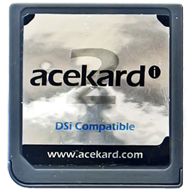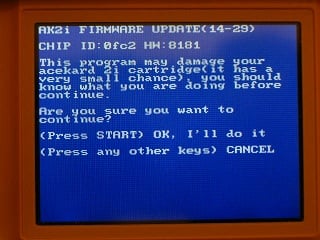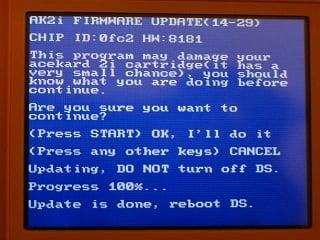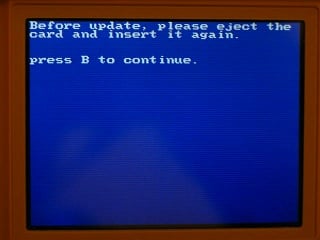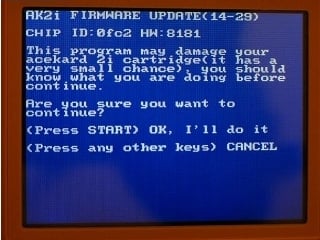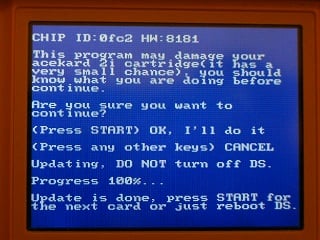Difference between revisions of "Updating the AK2i Bootloader"
(→External Links) |
|||
| Line 137: | Line 137: | ||
---- | ---- | ||
| − | |||
| − | |||
[[Category:Acekard]] | [[Category:Acekard]] | ||
Revision as of 01:50, 28 August 2011
On July 30, 2009 Nintendo released the first of 4 (1.4, 1.4.1, 1.4.2, 1.4.3) firmware revisions for the DSi. Each revision claimed to add background fixes to improve performance while secretly removing Flask Kits functionality. While each update has been optional, you must install the firmware update if you wish to use the DSi Browser or DSi Shop (IE: purchase/download DSi-Ware). Since the release of the 3DS, Nintendo has once again released firmware revisions (2.0.0-2) which bundle Flash Kit blocking amongst legitimate software updates. Updating, blocking, and re-flashing are inevitable processes of this hobby, thankfully the Acekard 2i continues to function on both the DSi and 3DS.
Team Acekard uses an older “generation 2” Flash Kit design, which is currently not the most ideal hardware for DSi/3DS bootloader exploits. The flashable bootloader of the 2i is not unlike “generation 3” Flash Kits, but requires actual ROM data to circumvent the DSi icon check and secondary data response check. More modern “generation 3” Flash Kit designs (SCDS2, iEVO, iSmart MM) require only an actual ROM icon to bypass the first check and spoof the secondary check with an updatable data file. Acekard’s older exploit method has forced users to wait for fully functional ROM data updates, which are pulled from a limited pool of known exploitable files. For the most part this older method has worked, that was until users began to notice the differences between the AK2i HWID 44 and 81 Flash Kits. The HWID 44 PCB uses an older design which can not be as easily updated. Currently there is no AK2i HWID 44 DSi v1.4.3 firmware solution nor is there a solution for the 3DS v2.1 firmware update.
When an AK2i does not contain the proper update the following error message will be displayed when attempting to boot the 2i:
An error has occurred. Press and hold the Power Button to turn the system off. Please see the Nintendo DSi Operations Manual for help troubleshooting.
Users, who wish to purchase DSi-Ware/eShop files, transfer DSi-Ware, or use the Web browser, should upgrade their system firmware knowing that it can never be downgraded. While the Public DSi-key was found it only allows for the decryption of things like DSi-Ware. Until access to the private key or a fully functionally DSi exploit is found a DSi firmware upgrade is permanent.
Contents
Before you begin
The firmware update can only be performed using a DS Phat, DS Lite, DSi, or 3DS, with a firmware version less than the exploit to be applied. If you are upgrading to the 1.4.3 exploit then the AK2i must first be updated and then the system itself, currently there is no way around this. However, DS Phat and DS Lite systems do not have upgradable firmware. Users who upgrade their DSi can always reflash the AK2i bootloader using one of these two older systems.
As new systems are built for retail the most recent firmware update is often applied. Users should keep this in mind when purchasing a new DSi or 3DS. If the user does not have access to a DS Phat or DS Lite then they are advised to purchase a fully updated AK2i from a respected reseller. For more information on resellers check out GBATemp’s Flash Kit reseller comparison Web site, ShopTemp
After updating, the Acekard will appear in the DSi menu using an actual game icon:
- Danny Phantom - Urban Jungle (DSi v1.4.0)
- Alex Rider: Stormbreaker (DSi v1.4.1)
- Atama de Do! Koten Kotenko DORASU (3DS v1.0.0-0)
- Chessmaster - The Art of Learning (DSi v1.4.2 & 3DS 2.0.0-2)
- Hello Kitty no Panda Sport Stadium DORASU (DSi v1.4.3)
As the icon is a key feature to circumventing the first check, the icons which change with each bootloader update can not be altered and attempting to do so would render the card unusable and unbootable.
Updating the firmware on any device comes with a degree of risk, the Acekard is no exception to this. If an error or interruption occurs during the flashing process, it may leave your Acekard in an inoperable state (bricked). While this is highly unlikely, it's something you should be aware of before flashing. There are several things you can do to minimize the risk of bricking your cart:
- Ensure the battery on your system is fully charged
- Ensure that your system is using the AC adapter (charger) and that it is plugged in.
- Use a verified working install of AKAIO on a microSD card properly formatted with the Panasonic formatter.
- Familiarize yourself with the AKAIO interface.
- Try to copy the firmware update files from the microSD card to another device, if successful this should mean that your microSD card is 100% readable.
In a worst case scenario it is possible to un-brick an Acekard 2i, which has been previously bricked, by the re-flashing bootloader. If you only own a DSi or 3DS that has been updated, re-flashing the bootloader will require a DS Phat or DS Lite and a second Flash Kit. The second Flash Kit will be used to run the multi-cart bootloader update, once run the user will swap in the bricked 2i and re-flash the bootloader.
Downloading the update
Official update releases should always be hosted at Acekard’s Web site. The most current update can be found in the links section below. Download the archive file to your computer and extract its contents. Upon extraction you should have two files, ak2ifw_update_3ds21__DSi143_onDSL_NO44.nds and ak2ifw_update_3ds21_DSi143_onDSi_NO44.nds (Please note that the names of the files may change).
The DSL update file has always retained a multi-kit update function, which allows for more than 1 Flash Kit to be flashed before being forced to power cycle the system. Acekard currently advises users to use the “onDSi” update on the DSi and the “onDSL” update on the DS Phat/DS Lite. If you are updating a single Flash Kit you can try the “onDSi” file. If you are updating more than one Flash Kit or un-bricking an AK2i by using another Flash Kit, use the “onDSL” file.
Updating a single cart
This can only be performed using a DS Phat/DSLite or a DSi/3DS running an older firmware than the one you are updating for.
Boot your Acekard and run ak2ifw_update_3ds21_DSi143_onDSi_NO44.nds, which will take you straight to the firmware update screen
Press (start), after the update is complete it gives you the following message:
The update is complete, you can now power off the console.
Updating Multiple carts
This can only be performed using a DS Phat or DS Lite
This is primarly used by retailers or people who are going sell their Acekard 2i. It allows you to update multiple Acekard Flash Kits in quick sucession. There is no need to swap memory cards, reboot the NDS or reboot into AKAIO between flashings.
Boot your Acekard and run ak2ifw_update_3ds21__DSi143_onDSL_NO44.nds.
You will get the following prompt:
Eject your Flash Kit and insert the first AK2i. You can also reinsert the same card if you wish. Press (B) and you get:
Press (start). Once the update is complete you get the following message:
Eject the Flash Kit and insert another. Press (start) and it will start flashing immediately, it will give no warnings, prompts or ask for confirmation. Repeat the process for as many carts as you have.
Unbricking a bricked cart
Bricked means a device is as electronically useful as a brick. Normally this will cause your Acekard to not appear in the DS menu, or for the DS to freeze as it displays the Health and Safety screen upon startup. If your Acekard intermittently appears in the DS Menu, then it will be a contact issue rather than being bricked and you should view the full guide
This un-bricking process can only be performed using a DS Phat or DS Lite, and is essentially the same as multi-kit bootloader flashing.
Boot a working Flash Kit (any Flash Kit) and run ak2ifw_update_3ds21__DSi143_onDSL_NO44.nds.
You will get the following prompt:
Eject your cart and insert the cart you wish to unbrick. Press (B) and you get:
Press (start). Once the update is complete you get the following message:
Important: power off now! Do NOT press (start).
You may see a longer 8 digit Chip ID, this is from where you Acekard is bricked. Upon a sucessful unbricking, it should return to normal 0FC2.
External Links
| Acekard | |
|---|---|
| Flashcarts | Acekard/+ • Acekard RPG • Acekard 2/2i |
| Software | AKAIO (Compatibility - How To - F.A.Q - GlobalSettings) |
| Official website - Acekard2 review | |

